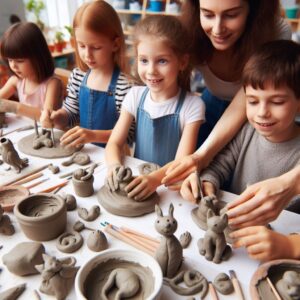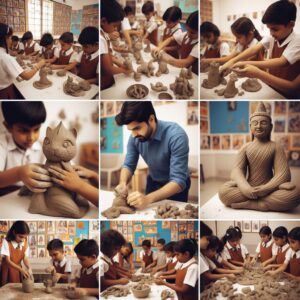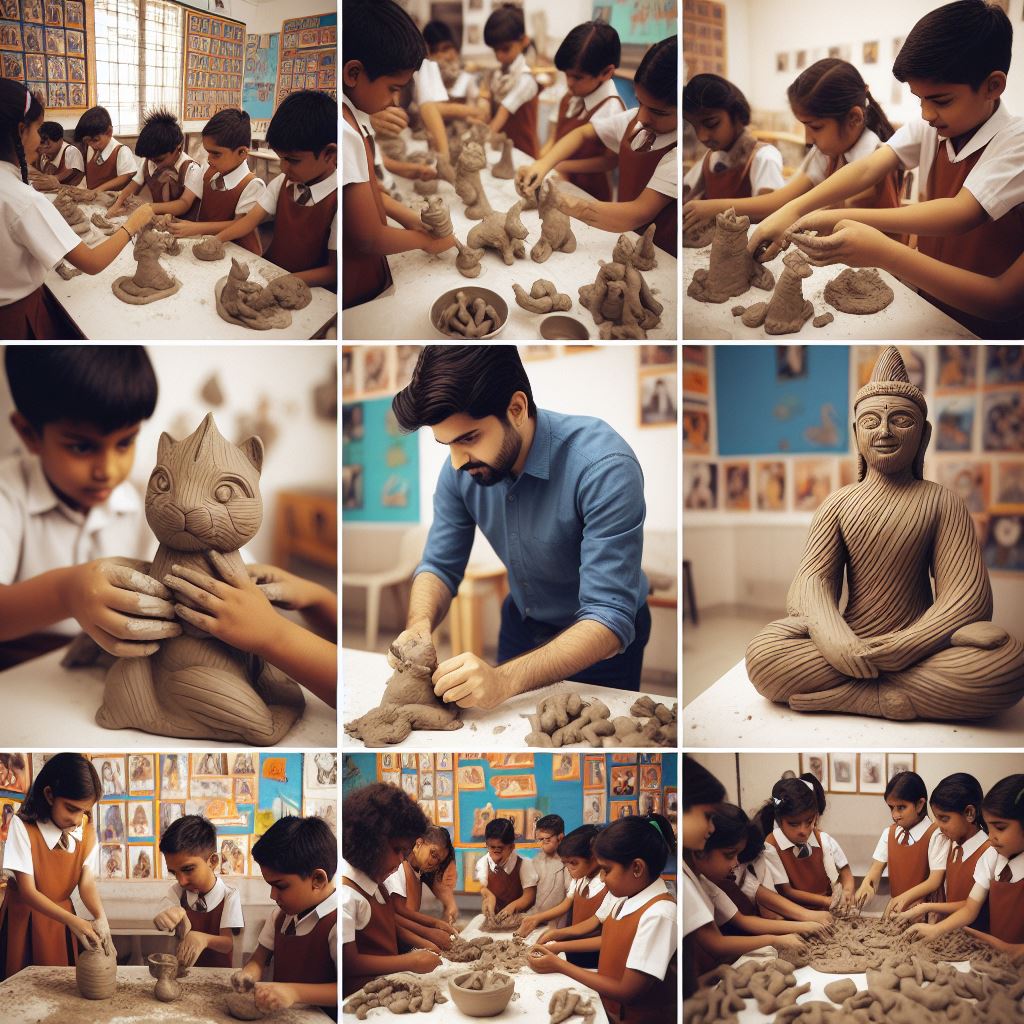Table Of Contents
- 1 Shaping Young Minds: Introduction to Promoting Clay Sculpting Workshops in Schools
- 1.1 Why Clay Sculpting?
- 1.2 Deciphering the Benefits and Challenges: Exploring Promoting Clay Sculpting Workshops in Schools
- 1.3 Benefits:
- 1.4 Challenges:
- 1.5 Shaping Success: Strategies and Resources for Implementing Clay Sculpting Workshops in Schools
- 1.6 Strategies for Success:
- 1.7 Clayful Conclusions:
- 1.8 Key Takeaways:
- 1.9 Frequently Asked Questions:
- 1.9.1 1. How much time is needed for a successful clay sculpting workshop?
- 1.9.2 2. What are the necessary safety precautions for clay sculpting workshops?
- 1.9.3 3. How do I assess student learning in clay sculpting workshops?
- 1.9.4 4. How can I engage parents and the community in clay sculpting workshops?
- 1.9.5 5. What are some online resources available for clay sculpting workshops?
Shaping Young Minds: Introduction to Promoting Clay Sculpting Workshops in Schools

Promoting clay sculpting workshops in schools is a valuable initiative that can enrich the lives of young people in numerous ways. This tactile and creative art form offers a unique opportunity for students to explore their artistic talents, develop essential skills, and foster their imagination. By incorporating clay sculpting into the school curriculum, we can open doors to a world of creativity, self-expression, and personal growth for young learners.
Why Clay Sculpting?
Clay sculpting provides numerous benefits for students:
- Enhances creativity and imagination: Molding clay allows children to express their ideas and emotions freely, fostering creativity and problem-solving skills.
- Develops fine motor skills: The hands-on nature of clay sculpting strengthens fine motor skills and dexterity, improving hand-eye coordination and control.
- Promotes sensory integration: The tactile experience of manipulating clay stimulates the senses and provides valuable sensory input, particularly for children with sensory needs.
- Boosts academic performance: Studies have shown that engaging in artistic activities like clay sculpting can improve academic performance in subjects like math and science.
- Increases focus and concentration: The act of sculpting requires concentration and attention to detail, enhancing focus and concentration skills.
- Provides a safe space for self-expression: Clay sculpting offers a safe and non-judgmental space for children to express themselves freely, building confidence and self-esteem.
- Fosters social interaction and teamwork: Collaborative clay sculpting projects encourage teamwork, communication, and social interaction among students.
Beyond these specific benefits, promoting clay sculpting workshops in schools can cultivate a love for art and appreciation for creative expression, enriching the educational experience and fostering a well-rounded development of young minds.
In the next , we’ll delve deeper into the meaning of “promoting clay sculpting workshops in schools,” exploring the specific benefits and potential challenges involved.
Deciphering the Benefits and Challenges: Exploring Promoting Clay Sculpting Workshops in Schools

As we continue our exploration of promoting clay sculpting workshops in schools, let’s delve deeper into the specific benefits and potential challenges involved in integrating this enriching artistic activity into the educational environment.
Benefits:
Academic Enhancement:
Studies have shown a positive correlation between engaging in artistic activities and improved academic performance. Clay sculpting, specifically, can enhance spatial reasoning and problem-solving skills, critical thinking, and even math and science concepts. By applying math concepts like ratios and fractions while measuring clay or exploring scientific principles like force and balance during construction, clay sculpting can provide a unique and engaging learning experience.
Social and Emotional Development:
Clay sculpting workshops offer a safe space for children to express themselves creatively, fostering self-confidence, self-esteem, and emotional well-being. Working collaboratively on projects promotes teamwork, communication, and social interaction, while also developing leadership skills and fostering a sense of belonging.
Sensory Integration:
The tactile nature of clay sculpting provides rich sensory input, stimulating the senses and promoting sensory integration. This is particularly beneficial for children with sensory processing needs, as the repetitive and calming nature of manipulating clay can offer a sense of comfort and focus.
Fine Motor Skills:
Kneading, shaping, and manipulating clay strengthens fine motor skills and hand-eye coordination, improving dexterity and control. This can be especially helpful for children who are struggling with developing strong fine motor skills, as clay sculpting provides a fun and engaging way to build these essential skills.
Creative Expression and Imagination:
Clay sculpting allows children to tap into their creative potential and express their ideas and emotions freely. The open-ended nature of this art form encourages exploration, experimentation, and problem-solving, while fostering creativity and imagination.
Challenges:
Resources and Materials:
Providing sufficient clay, tools, and other materials for a large group of students can be a challenge, requiring funding and organizational efforts. Additionally, access to proper drying and firing resources, if necessary, should be considered.
Integration with Curriculum:
Effectively integrating clay sculpting workshops into the existing curriculum can be challenging for educators, requiring careful planning and alignment with learning objectives across different subjects.
Training and Support:
Educators may require additional training and support in facilitating clay sculpting workshops effectively. This can involve workshops, online resources, or mentorship from experienced clay artists or educators.
Time Constraints:
Fitting clay sculpting workshops into the existing school schedule can be challenging, requiring creative solutions and scheduling adjustments.
Student Diversity:
Catering to the diverse needs and abilities of all students within a clay sculpting workshop can be challenging. This may involve providing differentiated instruction, offering alternative materials or techniques, and ensuring inclusivity for students with various learning styles and abilities.
Despite these challenges, the numerous benefits of promoting clay sculpting workshops in schools outweigh the obstacles. With careful planning, collaboration, and resource allocation, we can make this enriching artistic experience accessible and impactful for all students.
In the next session, we’ll explore practical strategies and resources for implementing successful clay sculpting workshops in schools.
Shaping Success: Strategies and Resources for Implementing Clay Sculpting Workshops in Schools

Armed with an understanding of the benefits and challenges of promoting clay sculpting workshops in schools, let’s embark on a practical exploration of strategies and resources that can pave the way for successful implementation.
Strategies for Success:
Collaboration:
- Partner with art teachers, classroom teachers, and administrators to secure support and integrate clay sculpting workshops into the curriculum.
- Seek partnerships with local community organizations such as art centers, museums, or artist guilds to access resources, expertise, and volunteers.
- Connect with other schools that have successfully implemented clay sculpting workshops to share best practices and learn from their experiences.
Planning and Organization:
- Define clear learning objectives aligned with the curriculum and specific age group of students.
- Choose appropriate clay types and tools based on the project, skill level, and budget.
- Develop lesson plans and activities that are engaging, age-appropriate, and differentiated to meet diverse needs.
- Secure a dedicated space with enough ventilation and access to water for cleaning and washing hands.
- Prepare materials in advance to ensure smooth workshop flow and avoid delays.
Instruction and Differentiation:
- Provide clear and concise instructions with visual aids and demonstrations.
- Offer differentiated instruction to cater to students with varying skill levels and learning styles.
- Encourage creativity and exploration while providing guidance and support.
- Incorporate elements of play and fun to maintain engagement and enjoyment.
- Celebrate individual efforts and achievements to foster confidence and motivation.
Resources and Funding:
- Explore grant opportunities from arts organizations, foundations, and educational institutions.
- Organize fundraising events to raise funds for materials and workshop expenses.
- Seek donations of clay, tools, and other supplies from local businesses or community members.
- Utilize online resources such as lesson plans, tutorials, and free downloadable materials.
- Consider partnering with parents or volunteers to assist with workshop setup, cleanup, and student support.
Technology and Innovation:
- Integrate technology into the workshops through online resources, interactive tools, or digital design platforms.
- Utilize multimedia presentations to showcase various clay sculpting techniques and inspire students.
- Encourage students to document their creative process through photography, videography, or digital storytelling.
Evaluation and Feedback:
- Regularly evaluate the effectiveness of the clay sculpting workshops by collecting feedback from students, teachers, and administrators.
- Use feedback to refine lesson plans, activities, and overall program design for continuous improvement.
- Celebrate student progress and achievements through exhibitions, presentations, or online platforms.
By implementing these strategies and utilizing available resources, schools can create engaging and impactful clay sculpting workshops that enrich the learning experience for all students. Remember, the key to success lies in collaboration, careful planning, differentiated instruction, and a commitment to providing a supportive and creative environment for young minds to explore the world of clay sculpting.
Next final, we’ll summarize key takeaways and address frequently asked questions, empowering you to champion the implementation of clay sculpting workshops in your own school community.
Clayful Conclusions:
As we conclude our exploration of promoting clay sculpting workshops in schools, let’s summarize key takeaways and address frequently asked questions, solidifying your knowledge and empowering you to advocate for this enriching artistic experience within your school community.
Key Takeaways:
- Promoting clay sculpting workshops in schools offers numerous benefits for students, fostering creativity, academic skills, social and emotional development, sensory integration, and fine motor skills.
- Challenges exist, including resource acquisition, curriculum integration, training for educators, time constraints, and catering to diverse student needs.
- Strategies for success involve collaboration, planning, differentiated instruction, effective resource utilization, technology integration, and ongoing evaluation.
- Numerous resources are available, including grant opportunities, online resources, community partnerships, and technological tools.
Frequently Asked Questions:
1. How much time is needed for a successful clay sculpting workshop?
The ideal time can vary depending on the age group, complexity of the project, and available resources. However, even short workshops of 30-45 minutes can be impactful with proper planning and structure.
2. What are the necessary safety precautions for clay sculpting workshops?
Ensure adequate ventilation in the workspace. Provide clear instructions and supervision to prevent injuries. Choose non-toxic clay types and encourage proper hand hygiene.
3. How do I assess student learning in clay sculpting workshops?
Observe their engagement, creativity, problem-solving skills, and attention to detail. Use formative assessments like observation checklists and rubrics to track progress and provide individualized feedback.
4. How can I engage parents and the community in clay sculpting workshops?
Organize parent workshops or volunteering opportunities. Invite community artists to lead guest sessions. Showcase student artwork through exhibitions or online platforms.
5. What are some online resources available for clay sculpting workshops?
Several websites offer free lesson plans, tutorials, and resources for educators and students. Explore online platforms like Pinterest, YouTube, and dedicated educational websites for inspiration and guidance.
By embracing the transformative power of clay sculpting workshops, we can empower students to explore their creativity, develop essential skills, and foster a lifelong love for art. Remember, the key lies in taking initiative, collaborating with your school community, and utilizing available resources to make this enriching experience a reality for young learners.
This concludes our exploration of promoting clay sculpting workshops in schools. We encourage you to champion this initiative within your own community and share your experiences with others. Let’s work together to bring the joy and benefits of clay sculpting to all young minds.
